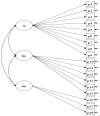Incremental Validity of ADHD Dimensions in the Predictions of Emotional Symptoms, Conduct Problems, and Peer Problems in Adolescents Based on Parent, Teacher, and Self-Ratings
- PMID: 39728736
- PMCID: PMC11677613
- DOI: 10.3390/pediatric16040095
Incremental Validity of ADHD Dimensions in the Predictions of Emotional Symptoms, Conduct Problems, and Peer Problems in Adolescents Based on Parent, Teacher, and Self-Ratings
Abstract
Background: The present study investigated the incremental validity of the ADHD dimensions of inattention (IA), hyperactivity (HY), and impulsivity (IM) in the predictions of emotion symptoms (ESs), conduct problems (CPs), and peer problems (PPs) in adolescents based on parent, teacher, and self- ratings. Method: A total of 214 ratings were collected from adolescents, their parents, and teachers in Australia. A structural equation modeling approach was employed to evaluated incremental validity. Results: The findings revealed that, controlling for gender, IM contributed moderate, low, and low levels of variance in predicting ESs based on parent, teacher, and self-ratings, respectively. Additionally, IM contributed moderate, substantial, and moderate levels of variance to CP predictions based on parent, teacher, and self-ratings, respectively. Furthermore, after controlling for gender, IM, and HY, parent-rated IA contributed a low level of variance to the prediction of ESs, while teacher and self-rated IA did not contribute significantly to the prediction of ESs, CPs, or PPs. Conclusions: The findings underscore the differential predictive validity of ADHD dimensions across informants and outcomes, highlighting impulsivity's stronger association with conduct problems and emotional symptoms. These results have theoretical and practical implications for understanding ADHD-related risks in adolescence and tailoring interventions accordingly.
Keywords: ADHD dimensions; conduct problems; emotion symptoms; incremental validity; peer problem.
Conflict of interest statement
The authors declare no conflict of interest.
Figures


Similar articles
-
Different heritabilities but shared etiological influences for parent, teacher and self-ratings of ADHD symptoms: an adolescent twin study.Psychol Med. 2013 Sep;43(9):1973-84. doi: 10.1017/S0033291712002978. Epub 2013 Jan 9. Psychol Med. 2013. PMID: 23298428 Free PMC article.
-
ADHD Parent and Teacher Symptom Ratings: Differential Item Functioning across Gender, Age, Race, and Ethnicity.J Abnorm Child Psychol. 2020 May;48(5):679-691. doi: 10.1007/s10802-020-00618-7. J Abnorm Child Psychol. 2020. PMID: 31938952
-
Predictive validity of parent- and self-rated ADHD symptoms in adolescence on adverse socioeconomic and health outcomes.Eur Child Adolesc Psychiatry. 2017 Jul;26(7):857-867. doi: 10.1007/s00787-017-0957-3. Epub 2017 Feb 10. Eur Child Adolesc Psychiatry. 2017. PMID: 28185096 Free PMC article.
-
Review: Which components of behavioral parent and teacher training work for children with ADHD? - a metaregression analysis on child behavioral outcomes.Child Adolesc Ment Health. 2023 May;28(2):258-268. doi: 10.1111/camh.12561. Epub 2022 Apr 13. Child Adolesc Ment Health. 2023. PMID: 35417075 Review.
-
Social skills training for attention deficit hyperactivity disorder (ADHD) in children aged 5 to 18 years.Cochrane Database Syst Rev. 2019 Jun 21;6(6):CD008223. doi: 10.1002/14651858.CD008223.pub3. Cochrane Database Syst Rev. 2019. PMID: 31222721 Free PMC article.
Cited by
-
Personality Traits in Adolescents with ADHD: Insights into Dimension Evaluation and Clinical Implications Using the Personality Inventory for the DSM-5 Questionnaire.J Clin Med. 2025 Apr 28;14(9):3048. doi: 10.3390/jcm14093048. J Clin Med. 2025. PMID: 40364080 Free PMC article.
References
-
- American Psychiatric Association . Diagnostic and Statistical Manual of Mental Disorders. 5th ed. APA; Washington, DC, USA: 2022. Text Rev. - DOI
-
- American Psychiatric Association . Diagnostic and Statistical Manual of Mental Disorders. 5th ed. APA; Washington, DC, USA: 2013. - DOI
-
- American Psychiatric Association . Diagnostic and Statistical Manual of Mental Disorders. 4th ed. APA; Washington, DC, USA: 2000. Text Rev. - DOI
-
- American Psychiatric Association . Diagnostic and Statistical Manual of Mental Disorders. 4th ed. APA; Washington, DC, USA: 1994.
LinkOut - more resources
Full Text Sources
Miscellaneous

